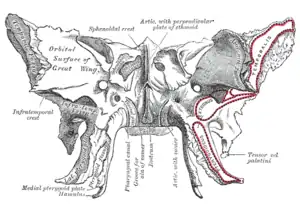| Sphenoidal conchae | |
|---|---|
 Sphenoid bone, upper surface. | |
 Sphenoid bone, anterior and inferior surfaces. | |
| Details | |
| Identifiers | |
| Latin | concha sphenoidalis |
| TA98 | A02.1.05.019 |
| TA2 | 603 |
| FMA | 54733 |
| Anatomical terms of bone | |
The sphenoidal conchae (sphenoidal turbinated processes) are two thin, curved plates, situated at the anterior and lower part of the body of the sphenoid. An aperture of variable size exists in the anterior wall of each, and through this the sphenoidal sinus opens into the nasal cavity.[1]
Each is irregular in form, and tapers to a point behind, being broader and thinner in front.
Its upper surface is concave, and looks toward the cavity of the sinus; its under surface is convex, and forms part of the roof of the corresponding nasal cavity.
Each bone articulates in front with the ethmoid, laterally with the palatine; its pointed posterior extremity is placed above the vomer, and is received between the root of the pterygoid process laterally and the rostrum of the sphenoid medially.
A small portion of the sphenoidal concha sometimes enters into the formation of the medial wall of the orbit, between the lamina papyracea of the ethmoid in front, the orbital plate of the palatine below, and the frontal bone above.
References
- ↑ Google books: sphenoidal conchae: General Anatomy and Osteology of Head and Neck (I. K. International Pvt Ltd, 2009; by Mahdi Hasan)- Retrieved 2018-08-29
![]() This article incorporates text in the public domain from page 152 of the 20th edition of Gray's Anatomy (1918)
This article incorporates text in the public domain from page 152 of the 20th edition of Gray's Anatomy (1918)